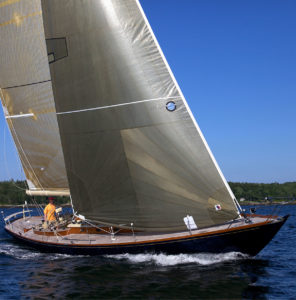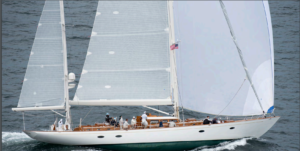
Hoi An’s modern sails make her much safer and easier to handle. But they don’t make her faster. Sorry, they really don’t
Sailing is not golf. Handicapping a sailboat race is a silly, silly idea: Length, weight, sail area, wetted surface are difficult to compare fairly. Nothing comes close to a simple “three-stroke handicap” that captures the subtle mix of tools that make a boat fast or slow. But, still, we sailors want to have fun, we don’t want confusing rules and penalties that are faulty in basis. Mostly we want to collect our friends and all our different boats, together at the same party, and race.
It’s what we do.
Today, we’re going to rant about the especially gnarly problem of rating penalties on sails inventory. We’ll tell you now, we see no logic for imposing penalties based on sail fabric. Leveling the regatta playing field is simply not that easy. Let’s bring some rationale to the current state of affairs regarding handicap racing and sails.
Overburdened Racing Rules
Classic and SOT racing organizations have over-burdened race penalties over the years. There appears to be two issues around sails that race committees believe should affect rating: The color and aesthetic of the fabrics used for vintage and classic boats; and, concerns over performance gains from higher tech, modern materials.
Rules like the International Mediterranean Committee, or CIM, rating system show what happens when the issues with sails are misunderstood by racing committees. Widely used in Europe, CIM seems to have employed a team of undergrad law students to draft up its Notices of Race. You’ll find detailed handicap penalties, it’s like the worst translation of Monopoly rules, or one of those you-tube bad-lip-reading videos for a beer pong frat party. Confounding!
Further reading of CIM rules reveal ever-more granular definitions for all kinds of things, particularly sail materials and rating adjustments for these materials; all this renders up a hazy, hard-to-follow logic that has led to some frankly nutty regulations. Of many terrible examples for abuse in regulations is in the Panerai series regattas that flatly prohibit (!) modern materials in classic yachts. Further, some regattas adapt parts of the rule and prescribe boats a separate class created solely for boats carrying modern sails, as if curing some sort of affliction. And, we say, ‘What?’
Here’s a taste of the goofy Panerai rules:
-
Only woven fabric (canvas, nylon, Dacron as well as more contemporary woven fabrics such as Vectran and Hydranet) are permitted.
-
Sails utilizing advanced shaping technologies (3DL or similar), laminate or composite construction, or materials such as, but not limited to, Mylar, Kevlar, Spectra, Carbon Fiber, etc. are prohibited.
-
Modern square top mainsails are prohibited.
It’s impossible to understand what race committees are trying to accomplish with these kinds of restrictions. As knowing professionals, we see real trouble in hitting owners with penalties for regularly updating and maintaining their boats.
The Materials are Immaterial.

It’s easy to think these state-of-the art 3Di sails are the most important thing to race-winning boats like Bequia. But they are only part of an integrated approach to speed that includes rigs, appendages and, most of all, good teams that sail these boats well.
Let’s take a sober look at what really gives a sailing yacht the ability to power through the water: Ignoring appendages, driving force is solely delivered via an equilibrium of a boat’s displacement and the configuration of a sail plan. Any given design has a set amount of sail area that is designated by her designer to suit the yacht’s mission and intended design. Because of these facts, there is a clear — and finite (!) — limit on the resources available to make a boat perform to her potential. Displacement vessels, in which most handicap racing is done, are governed by the limit of their hull speed. That limit places the burden of efficient sailing almost entirely on the crew and helmsman. A well-oiled sailing machine is about the people driving that vessel, as much as the machine or the sails themselves. We can only fill the triangles of a sail plan with so much sailing horsepower.
Sails are the consumables of sailing, yet the ratio of square footage to displacement is all the horsepower you get. Keeping a good sail inventory is essential to a sailboat’s ability to move. Why would we penalize or limit any vessel for its skippers’ due diligence with the essential driving components of a boat?
Limiting sail fabrics comes with increasingly more problematic logic and absolute downsides. One, is a lack of technological development. Making sailing safe and exciting is supported by new technologies and materials. Higher tech sails are lighter, stronger and hold their shape longer. They’re also easier to handle. That’s easier on your boat, and easier on your crew. But the reality is, these minute weight improvements in sails are barely measurable. The material of those sails does not win a race.
The overall performance of a boat comes down to good maintenance, a mix of features and the crew’s ability to win that race. Period.
Development Helps Everybody
Developing technologies are already improving the calculus of the skipper’s checkbook. A captain who purchases newly molded 3Di North sails might see a service life of ten years, without too much wear-n-tear. While the skipper who settles for old-school Dacron may need multiple sets in that time to remain competitive. That’s the new math of innovation: The material is no single boost to performance, and there are trade-offs in durability.
It’s no secret that part of enjoying a boat includes investing properly in that boat over its lifetime. Updated sails and rigging are small parts of the ongoing maintenance, our point is the culture of racing should encourage the implementation of the newest materials for things like sails and rigging. Let’s protect a thoroughbred credential, keep a competitive edge and maintain value.
A fast boat in good shape is a more enjoyable and more valuable boat.
Buying and maintaining sails is only a fraction of ownership costs. A fresh set of sails is like pushing the reset button on your boat. It returns the boat you love to a state of performance readiness that was the designer’s intent. Prohibiting sail upgrades is quite literally a slow and steady “undesign” that boat. Why on earth would anybody seek to un-own the boat they paid so dearly for in the first place?
Can rating systems improve? We suggest adopting the “less, is more” approach — less governance, more fun. Let’s keep handicap racing fun and avoid punitive measures that have little merit for equalizing a fleet.